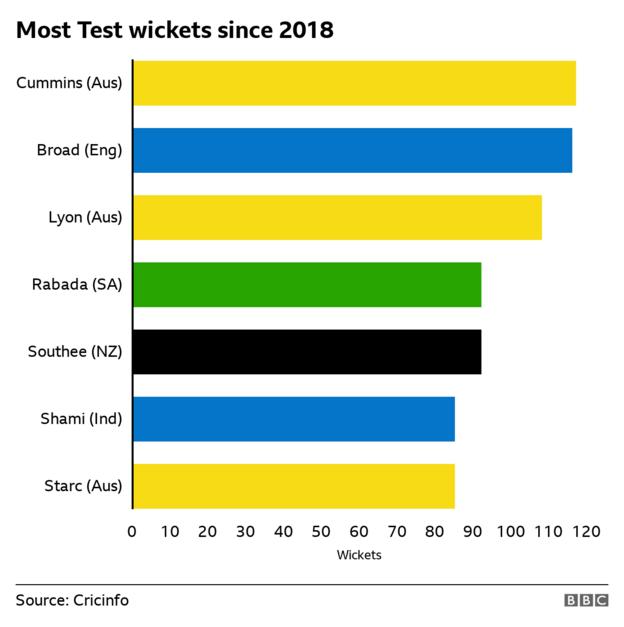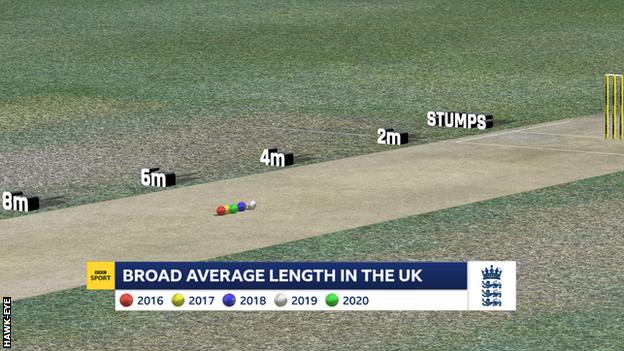It’s been said so many times now, it has almost become cricketing logic: Australia is no country for old men.
Certainly not ‘old’ fast bowlers.
But do the stats really add up? Should England be considering going to Australia next winter without James Anderson and/or Stuart Broad, a pair of bowlers with more than 1,100 Test wickets and almost 300 Test caps between them?
That was the inference when England dropped Broad for the first Test against West Indies last summer, before he came roaring back in style.
And what about the more pressing conundrum of facing Sri Lanka and India in their own conditions?
Eleven months out from the Ashes – one of England’s biggest assignments in 2021 – BBC Sport has been crunching the numbers… and the results are not what you might expect.
Getting better with age?

First things first – there is no data to suggest Anderson and Broad are losing their powers with age. If anything, they seem to be getting better.
Only Australia’s Pat Cummins has taken more wickets – one to be precise – than Broad’s 116 since the beginning of 2018. Anderson is eighth on the same list (78 wickets).
Where Anderson has the edge is the control he offers – he has the best economy rate of any bowler to have taken more than 75 wickets in the past three years (2.48), which is significantly better than everyone else (the next best is, rather surprisingly, New Zealand’s bouncer king Neil Wagner, 2.66).
It’s also logical to assume the effects of a Covid-ravaged cricket calendar could prolong the careers of players like Anderson and Broad, who have extra recovery time they might not previously have been afforded between series.
Hang on, are those improved stats because of recent performances in England?
In a word, no. While it’s fair to say Anderson and Broad are peerless in English conditions, they have been pretty effective overseas in recent years too.
On England’s most recent Test tour, in South Africa in early 2020, only home pace bowler Anrich Nortje took more wickets than Broad’s 14 in four matches.
Since 2018, Anderson and Broad have taken 63 wickets between them away from home – with both men averaging a creditable 27.
In that time, England have played in Australia, New Zealand, South Africa, Sri Lanka and West Indies.
On that tour of Australia, Anderson was impressive in a losing cause, taking 17 wickets at 27.82 and going at just two an over.
Only the expensive Craig Overton had a better strike-rate of the recognised bowlers, with the Australians seemingly content to see off England’s main threat and cash in on the lesser effective members of the attack.
OK, but those countries are hardly bowlers’ graveyards…
No, they aren’t – but here’s the interesting thing.
Since his Test debut in 2003, no pace bowler has taken more wickets in India than Anderson’s 26 at 33.46 (South Africa’s Dale Steyn also has 26, at 21.38).
Broad’s record in India is a little more modest – 10 wickets at 53.90 – but it’s instructive to consider two things in his favour.
Pakistan have been based in the UAE since 2009 and, of all the visiting bowlers, only Sri Lanka spinner Rangana Herath has a better record both in terms of wickets taken and economy rate than England’s legendary duo.
In the UAE, Anderson and Broad provide control – going for just two runs an over on average – and a genuine wicket-taking threat, with their strike-rate remarkably similar to their career strike-rate.
The second thing which could play into Broad’s favour is India’s desire to no longer produce raging turners.
While they still possess one of the best spinners in the world – Ravichandran Ashwin – they have a fearsome fast bowling attack, led by Jasprit Bumrah, which is just as potent.
India also use the SG cricket ball, which has a more pronounced seam, stays harder for longer and reverses sooner. That will suit Anderson and Broad.
What about Australia?

Consider this: the last time England won in Australia in 2010-11, their bowlers were, to an extent, horses-for-courses selections.
In the first three Tests in Brisbane, Adelaide and Perth, they went for the extra pace and bounce of Steven Finn.
When they wanted more control on slower wickets in Melbourne and Sydney, they drafted in Tim Bresnan.
Chris Tremlett came in to play a key role from the third Test onwards when Broad was injured.
So how could that work this time around?
For starters, who wouldn’t want Anderson playing under lights in the Adelaide day-night Test? Australians need not answer that question.
And surely Broad’s height and bounce will be well suited to Brisbane and Perth? Especially since he is bowling a fuller length, which is bringing renewed rewards and is more likely to suit Australian pitches, which previously saw Broad’s older-style back-of-a-length deliveries sail over the top of off stump.
After all, nobody of an English persuasion wants another winter of Steve Smith watching it go through to the keeper off a good length.
| Tests | Wickets | Average | Economy rate | |
| Anderson | 18 | 60 | 35.43 | 2.95 |
| Broad | 12 | 34 | 37.17 | 2.96 |
Jofra Archer is likely to be in the frame to play all five Tests, leaving Mark Wood, Chris Woakes, Olly Stone and Overton to alternate when conditions suit.
Wood’s extra pace, for example, might be utilised in the first Test in Brisbane and the third in Perth. His record away from home is phenomenal, too – he averages 44.91 at home compared to 18.50 away.
Woakes averages 50 in Australia, albeit across only four Tests, but was effective in Adelaide on the most recent tour down under.
England should also have the added benefit of Ben Stokes next winter, after he missed the previous tour because of the court case which followed a now infamous incident outside a Bristol nightclub.
The all-rounder took 15 wickets at 32.80 in his only previous Ashes tour and can be expected to do similar things next time he faces Australia.
And is it actually all down to the bowlers themselves?
Speaking to The Cricketer recently, Broad flipped the argument on its head.
“I think with Australia we sometimes get caught up in this: ‘You have to take 90mph or 95mph bowlers, they’ll win you it in Australia,'” he said. “But actually, in my opinion, it’s runs.
“You need 550 on the board. Let’s see how the Australian batsmen play with 550 on the board.”
So Australia IS a country for old men?

Kind of. England will surely want to go to India and Australia with their two old stagers in tow… and rightly so. Both men are off to Sri Lanka in the next few days.
The stats show they can be both effective and help provide a balanced attack in all conditions.
It’s doubtful both will be required in every Test – it would be surprising if England did not to consider extra pace at certain venues, particularly in Australia – but don’t bet against Anderson and Broad reprising the famous sprinkler dance of 2010-11 in Sydney in early 2022.






















